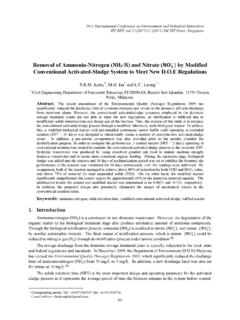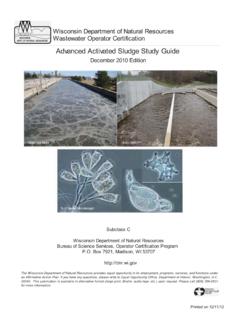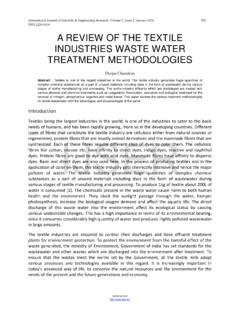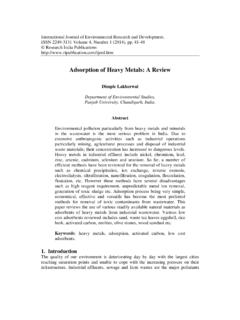Transcription of Wastewater Technology Fact Sheet: Package Plants
1 United StatesEnvironmental ProtectionAgencyOffice of WaterWashington, 832-F-00-016 September 2000 WastewaterTechnology Fact SheetPackage PlantsDESCRIPTIONP ackage Plants are pre-manufactured treatmentfacilities used to treat Wastewater in smallcommunities or on individual to manufacturers, Package Plants can bedesigned to treat flows as low as MGD or ashigh as MGD, although they more commonlytreat flows between and MGD (Metcalfand Eddy, 1991).The most common types of Package Plants areextended aeration Plants , sequencing batch reactors,oxidation ditches, contact stabilization Plants ,rotating biological contactors, andphysical/chemical processes (Metcalf and Eddy,1991).
2 This fact sheet focuses on the first three, allof which are biological aeration aeration plantsThe extended aeration process is one modificationof the activated sludge process which providesbiological treatment for the removal ofbiodegradable organic wastes under aerobicconditions. Air may be supplied by mechanical ordiffused aeration to provide the oxygen required tosustain the aerobic biological process. Mixing mustbe provided by aeration or mechanical means tomaintain the microbial organisms in contact withthe dissolved organics.
3 In addition, the pH must becontrolled to optimize the biological process andessential nutrients must be present to facilitatebiological growth and the continuation of depicted in Figure 1, Wastewater enters thetreatment system and is typically screenedimmediately to remove large suspended, settleable,or floating solids that could interfere with ordamage equipment downstream in the may then pass through a grinder toreduce large particles that are not captured in thescreening process. If the plant requires the flow tobe regulated, the effluent will then flow intoequalization basins which regulate peak wastewaterflow rates.
4 Wastewater then enters the aerationchamber, where it is mixed and oxygen is providedto the microorganisms. The mixed liquor thenflows to a clarifier or settling chamber where mostmicroorganisms settle to the bottom of the clarifierand a portion are pumped back to the incomingwastewater at the beginning of the plant. Thisreturned material is the return activated sludge (RAS). The material that is not returned, the wasteactivated sludge (WAS), is removed for treatmentand disposal. The clarified Wastewater then flowsover a weir and into a collection channel beforebeing diverted to the disinfection (if required)ExtendedAerationDigestionTo Solids Handling,Disposal, orBeneficial ReuseClarificationDisinfectionEffluentWa ste ActivatedSludge (WAS)Return ActivatedSludge (RAS)Source.
5 Parsons Engineering Science, 1 PROCESS FLOW DIAGRAMFOR A TYPICAL EXTENDED AERATIONPLANTE xtended aeration Package Plants consist of a steeltank that is compartmentalized into flowequalization, aeration, clarification, disinfection,and aerated sludge holding/digestion aeration systems are typicallymanufactured to treat Wastewater flow ratesbetween to MGD. Use of concrete tanksmay be preferable for larger sizes (Sloan, 1999).Extended aeration Plants are usually started upusing "seed sludge " from another sewage plant. Itmay take as many as two to four weeks from thetime it is seeded for the plant to stabilize (Sloan,1999).
6 Sequencing batch reactorsA sequencing batch reactor (SBR) is a variation ofthe activated sludge process. As a fill and draw orbatch process, all biological treatment phases occurin a single tank. This differs from the conventionalflow through activated sludge process in that SBRsdo not require separate tanks for aeration andsedimentation (Kappe, 1999). SBR systems containeither two or more reactor tanks that are operated inparallel, or one equalization tank and one reactortank. The type of tank used depends on thewastewater flow characteristics ( high or lowvolume).
7 While this setup allows the system toaccommodate continuous influent flow, it does notprovide for disinfection or holding for are many types of SBR systems, includingcontinuous influent/time based, non-continuousinfluent/time based, volume based, an intermittentcycle system (a SBR that utilizes jet aeration), andvarious other system modifications based ondifferent manufacturer designs. The type of SBRsystem used depends on site and wastewatercharacteristics as well as the needs of the area orcommunity installing the unit.
8 Package SBRs aretypically manufactured to treat Wastewater flowrates between and MGD; although flowrates can vary based on the system seen in Figure 2, the influent flow first goesthrough a screening process before entering theSBR. The waste is then treated in a series of batchphases within the SBR to achieve the desiredeffluent concentration. The sludge that is wastedfrom the SBR moves on to digestion and eventuallyto solids handling, disposal, or beneficial treated effluent then moves to disinfection.
9 Anequalization tank is typically needed before thedisinfection unit in batch SBRs in order to storelarge volumes of water. If the flow is not equalized,a sizable filter may be necessary to accommodatethe large flow of water entering the disinfectionsystem. In addition, SBR systems typically have noprimary or secondary clarifiers as settling takesplace in the are normally five phases in the SBRtreatment cycle: fill, react, settle, decant, and length of time that each phase occurs iscontrolled by a programmable logic controller(PLC), which allows the system to be controlledfrom remote locations (Sloan, 1999).
10 In the fillphase, raw Wastewater enters the basin, where it ismixed with settled biomass from the previous aeration may occur during this phase. Then,in the react phase, the basin is aerated, allowingoxidation and nitrification to occur. During thesettling phase, aeration and mixing are suspendedand the solids are allowed to settle. The treatedwastewater is then discharged from the basin in thedecant phase. In the final phase, the basin is idle asit waits for the start of the next cycle. During thistime, part of the solids are removed from the basinand disposed of as waste sludge (Kappe, 1999).













